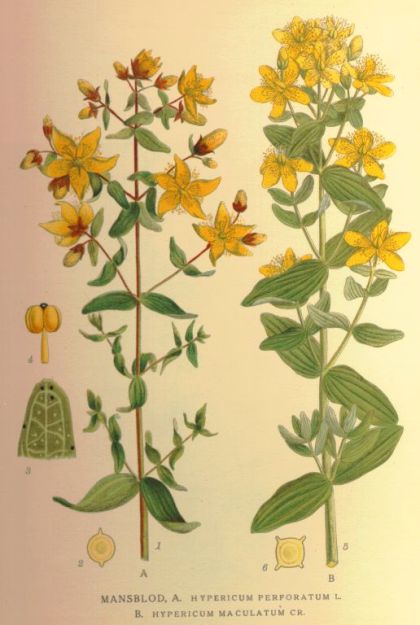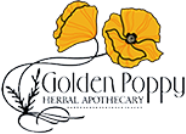Unlike the malt-infused liquid that is extracted during the brewing process of beer or whiskey, the term 'wort' in the herbal identity of Saint John’s wort is derived from an Old English word meaning ‘plant’. The etymology associated with this herb is actually quite gory. Saint John’s wort refers to the bright red dye released when the plant is crushed up. The herb's coloration emulates blood, linking it to the gruesome beheading of John the Baptist. Hence, Saint John’s wort. This herb is commonly picked on June 24
th, the feast day of John the Baptist. In folkloric tradition, simply placing a sprig of this wort under your pillow on Saint John’s Eve was thought to bring special blessings and protection from death in the coming year. Saint John’s wort has been used for over one thousand years to treat depression. It has been proposed that this herb inhibits the synaptic reuptake of serotonin, norepinephrine, and dopamine. Regardless of the mechanism, Saint John’s wort is renowned for its powerful mood-improving benefits. This herb can also be used topically. Oil infused from Saint John’s wort is commonly used to treat back pain, bruises, burns, hemorrhoids, herpes, nerve pain, sunburn, ulcers, varicose veins, and wounds. In addition to being an amazing plant and powerful healer, this plant holiday falls on our owner's birthday, so this plant is a particular favorite. Celebrate this happy and historical herb on June 24th or, all week long!

MATERIA MEDICA: SAINT JOHN’S WORT
Latin Name:
Hypericum perforatum Family: Hypericaceae
Botanical Description The plant, which consists of many branching stems, grows to a height of 1 to 3 feet. The pale green, oblong leaves are approximately 1 inch long and arranged oppositely along the stem (Foster, 1993). By holding a leaf up to the light, one can see tiny dots that appear to be perforations; in fact, they are a translucent layer of oil glands. The bright yellow five-petaled flowers, which are arranged in a flat-topped cluster at the end of the branching stems, are approximately one inch across and are covered with tiny black dots that release a red oil.
Sustainability Issues: None known. Considered an invasive weed in the rangelands of western North America and Australia due to its aggressive growth.
Harvesting Guidelines: The open flowers, flower buds and leaves from the top 2-3 inches of the plant are harvested during full bloom from June through August
Part used: Flowering top
Energetics: Bitter, sweet, cool, dry
Key Constituents: Dianthrones (hypericin and pseudohypericin), essential oils, tannins, flavonoids, resins, plant acids, alkaloids, phloroglucinols (hyperforin) (Foster, 1993; Hoffman, 2003; Holmes, 1997).
Actions: Antibacterial, antidepressant, anti-inflammatory, antioxidant, antiviral, aromatic, digestive, diuretic, nerve restorative, vermifuge and vulnerary
Uses:
- Attention deficit hyperactivity disorder (ADHD)
- Anxiety disorders
- Depression in certain situations and certain people
- Dermatitis
- Insomnia
- Irritability
- Nerve pain
- Nervous system restoration
- Nervous system viruses (HPV, HIV, Shingles…)
- Premenstrual syndrome (PMS)
- Seasonal Affective Disorder (SAD)
Preparation and Dosage
- Tea – 1-2 teaspoons, infuse for 10-15 minutes
- Tincture – 1-4 ml/3 times a day
- Infused Oil - apply topically to areas in need of nerve restoration such a sprains and strains, as well as skin affected by nervous system viruses such as shingles and herpes
Safety considerations:
- Saint John’s wort should be avoided by patients with known allergies or hypersensitivities to the herb.
- This herb should not be combined with anti-depressant pharmaceuticals, protease inhibitors or other pharmaceutical drugs, such as oral contraceptives. Saint John’s wort can reduce the bioavailability of these pharmaceuticals decreasing their overall effectiveness.
- It also interacts with birth control medications as well as many other medications, so double check with an herbalist, doctor, or pharmacist before taking St. John's Wort if you take any medications.
- It is also not recommended to utilize this herb during pregnancy, while nursing or for children under the age of 2.
Resources:
- Herbal Academy's Herbarium Monograph
- American Botanical Council (1999). The Complete German Commission E Monographs: St. John’s Wort. Retrieved on October 20, 2014 from http://cms.herbalgram.org/commissione/Monographs/Monograph0347.html.
- American Botanical Council (2000). Herbal Medicine: Expanded Commission E Online: St. John’s Wort. Retrieved on October 20, 2014 from http://cms.herbalgram.org/expandedE/StJohn27swort.html.
- Chevallier, Andrew. (1996). The Encyclopedia of Medicinal Plants. New York, NY: DK Publishing, Inc.
- Edwards, Gail Faith. (2000) Opening Our Wild Hearts to the Healing Herbs. Woodstock, NY: Ash Tree Publishing.
- Foster, Steven. (1993) Herbal Renaissance. Layton, UT: Peregrine Smith Books.
- Grieve, Margaret. (1913). A Modern Herbal. Retrieved on October 20, 2014 from http://botanical.com/botanical/mgmh/s/sajohn06.html.
- Hardin, Kiva Rose (2014). Gifts of the Solstice: Native St. John’s Wort. Retrieved on October 20, 2014 from http://bearmedicineherbals.com/gifts-of-the-solstice-native-st-johns-wort.html.
- Hoffman, David. (2003) Medical Herbalism. Rochester, VT: Healing Arts Press.
- Holmes, Peter. (1997). The Energetics of Western Herbs, Volume 1, Revised Third Edition.
- Laakmann G, Schüle C, Baghai T, Kieser M. (1998). St. John's wort in mild to moderate depression: the relevance of hyperforin for the clinical efficacy. Pharmacopsychiatry. 1998 Jun;31 Suppl 1:54-9.
- Linde K, Berner M, Kriston L. (2008). St John’s wort for major depression. Cochrane Database Syst Rev 2008;4:CD000448.
- McIntyre, Anne. (1996) Flower Power. New York, NY: Henry Holt and Company, Inc.
- Miller AL. (2005). Epidemiology, etiology, and natural treatment of seasonal affective disorder. Altern Med Rev. 2005 Mar;10(1):5-13.
- National Center for Complementary and Alternative Medicine, National Institute of Health. (2013). St. John's Wort and Depression. Retrieved on October 22, 2014 from http://nccam.nih.gov/health/stjohnswort/sjw-and-depression.htm#science.
- Samadi S, Khadivzadeh T, Emami A, Moosavi NS, Tafaghodi M, Behnam HR. (2010). The effect of Hypericum perforatum on the wound healing and scar of cesarean. J Altern Complement Med. 2010 Jan;16(1):113-7.
- Tierra, Lesley. (2003). Healing with the Herbs of Life. Berkeley, CA: Ten Speed Press.
- Tillotson, Alan Keith. (2001). The One Earth Herbal Sourcebook. New York, NY: Kensington Publishing Group.




